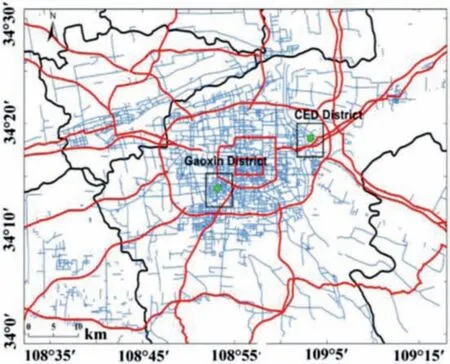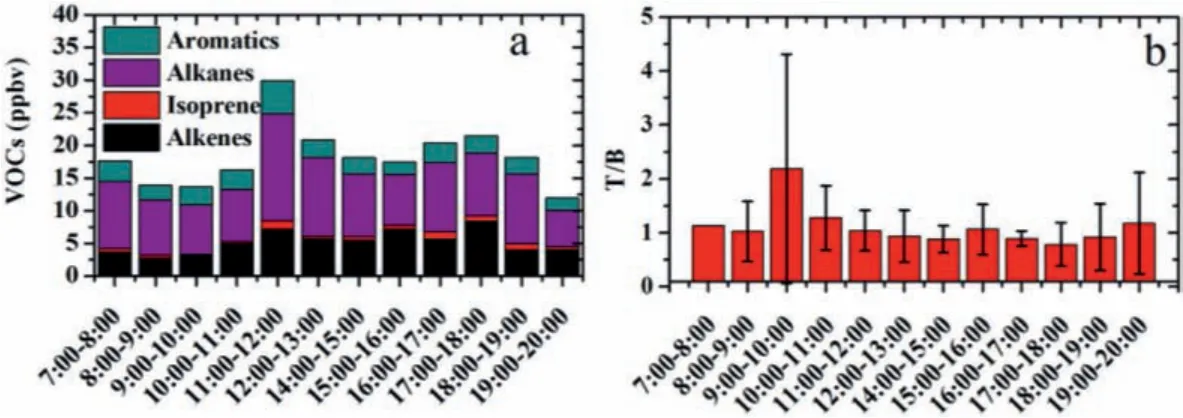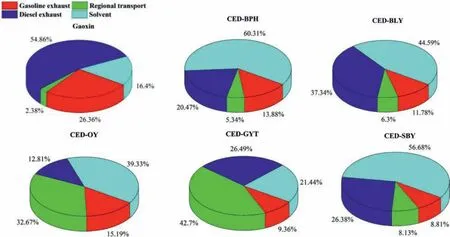High impact of vehicle and solvent emission on the ambient volatile organic compounds in a major city of northwest China
Yonggang Xue, Liqin Wang, Suixin Liu, Yu Huang,*, Long Chen,Long Cui, Yan Cheng, Junji Cao
a State Key Lab of Loess and Quaternary Geology (SKLLQG), Institute of Earth Environment, Chinese Academy of Sciences (CAS), Xi’an 710061, China
b CAS Center for Excellence in Quaternary Science and Global Change, Xi’an 710061, China
c Guanzhong Plain Ecological Environment Change and Comprehensive Treatment National Observation and Research Station, Xi’an 710061, China
d School of Human Settlements and Civil Engineering, Xi’an Jiaotong University, Xi’an 710049, China
Keywords:VOCs Vehicle exhaust Fuel evaporation Solvent using Northwest China
ABSTRACT Monitoring of ambient volatile organic compounds (VOCs) was conducted within typical residentialcommercial area in the city of Xi’an in northwest China during typical ozone (O3) episodes, to investigate the major contributors to the characteristic of ambient VOCs and their impact on O3 production.In the residential-commercial area, diurnal variation of VOCs was highly impacted by vehicle exhaust, fuel evaporation, and local solvent use.Relative higher contributions (up to 60%) of VOCs from solvent use to the ozone formation potential were found.The present findings highlight the urgent need for restrictions on the emission of VOCs from solvent use and non-vehicle-traffic-related sources, such as oil storage.
Ozone (O3) is closely linked to air quality, public health risks,and climate change [1,2].In recent years, ground-level O3has increased around most megacities in China [3,4].Both unfavorable meteorological conditions and the continuous emission of O3precursors have been identified as key contributors [5–8].Observation-based model demonstrates the substantial contribution of volatile organic compounds (VOCs) to O3formation in China’s megacities [9].
Traffic emissions constitute one of the largest sources of ambient VOCs [10–12].However, few studies have been conducted on the stable sources of VOCs in locations neighboring high-traffic areas [13–15].In addition, the progressive rise in VOC emissions from solvents has been found to play increasingly essential roles in O3production, to which higher photochemical reactivity also contributes [13–16].
The Guanzhong Basin (GZB) city cluster was listed as a key area for air pollution control by the China Ministry of Environmental Protection in northwest China.Specifically, both Xi’an (the largest city in the central of GZB) and its surrounding area face increasingly serve O3episodes in the recent years [17,18].
The present study was conducted to investigate the characteristic and major contributors of ambient VOCs in two types of residential area, where high density of anthropogenic activities condensed.The sampling sites were chosen in a traffic busy area with high dense commercial activities and a residential area nearby transit highway in warm season.The contributions of various sources to ambient VOCs concentrations in different regions were determined, and potential factors influencing the variation of ambient VOCs and their impacts on ozone formation potential(OFP) were discussed.
As described above, two areas were chosen (Fig.1).The first sampling area was chosen in the Gaoxin district in west Xi’an, an area characterized by busy traffic and high density of commercial activities.Sample collection was conducted on the rooftop of a three-story building managed by the Institute of Earth Environment of the Chinese Academy of Sciences.

Fig.1.Locations of sampling sites and the road network in the city of Xi’an.
The second sampling area was chosen in Chanba ecological district (CED) in east Xi’an, where few large-scale industries but scattered garages were found.In another aspect, a national highway passes through this district.The ambient VOCs were drawn into multibed adsorbent tubes (fixed Tenax TA, Carbogragh) with an ACTI-VOC low-flow sampling pump (Markes International Ltd.) at a flow rate of 50 mL/min.The analytes in the adsorbent tubes underwent thermal desorption (TD) on a UNITY-ULTRA-xr system (Series 2, Markes, UK).They were also subjected to GC/MS (7890A/5977B,Agilent Technology, Santa Clara, CA, USA).Detailed descriptions onsampling and data quality control were given in Texts S1-S4 (Supporting information).
The average mixing ratios of total quantified VOCs were 18.3 ± 9.7, 35.6 ± 22.0 ppbv in the area of Gaoxin and CED districts, respectively (Table 1).Composition of ambient VOCs varied significantly both among different areas in the present study,and among different Chinese cities [19–23].Proportion of alkenes was far higher in the area of Gaoxin district, a typical residentialcommercial area with busy traffic and high density of commercial activities.Therein, ethylene (2.3 ± 1.3 ppbv), propene (1.2 ± 0.7 ppbv), and 1-butene (0.5 ± 0.2 ppbv) were the most abundant alkenes.The proportion of alkanes (44%-52%) measured in the present study was similar to that in the cities of Beijing (43%) and Guangzhou (~56%), but lower than that in Hong Kong where excess LPG was used as vehicle fuel [19–23].This indicated vehicle exhaust dominated the emission of VOCs in the area of Gaoxin district [24].And in the area of CED district, surprisedly high proportion of aromatics was observed, the toluene to benzene ratio(T/B) ratio was found to vary significantly between 0.16 ± 0.03 to 4.26 ± 6.95 among different sampling sites in the area of CED(Fig.S1 in Supporting information).Further correlation analysis and source apportionment implied strong impacts of local solvent using, fuel evaporation and regional transport of air mass on the composition of ambient VOCs (described below).

Table 1 Levels (ppbv) and compositions (%) of ambient VOCs in the present study and comparison (summer) with other cities in China.
As described above, the Gaoxin district is a typical residentialcommercial area with high density of vehicles.As shown in Fig.2,ambient VOCs concentrations peaked in the morning rush hours, at noon, and in the evening rush hours in this area.In general, diurnal variations of ambient VOCs in urban areas are mainly affected by vehicle exhaust, mixing layer depth, and photochemical reactivity [12,19,21].This explained why high and low loadings were mostly observed during rush hours and in the afternoon in the present study, respectively.Moreover, high toluene/benzene (T/B)ratios were noted during rush hours.Toluene and benzene are key components of vehicle exhaust plumes.Considering that toluene has a shorter lifetime than benzene, it can be concluded that fresh vehicle emissions were major contributors to the high VOC concentration and T/B values during rush hours [25,26].Additional VOC peaks were observed between 11:00 and 13:00, without correspondingly higher T/B ratios.The higher concentrations of VOCs under high temperatures at noon, particularly isopentane, are indicative of strong gasoline evaporation [24,27].

Fig.2.Diurnal variation of VOCs (a) and T/B ratio (b) in typical congested area of Xi’an.
The temporal variation of ambient VOCs in the CED differed significantly from that in the area of Gaoxin district.Furthermore, this variation followed the same pattern as that of surface winds (Fig.S2 in Supporting information).On one sampling day, VOC peaks were primarily noted in the afternoon, when a strong wind was blowing in the northeast (Fig.S2).Similar trends were observed on different sampling days.Notably, ambient VOC concentrations began increasing on July 4, when the dominant winds changed from southeast to northeast.During the field investigation, numerous oil tanks were found northeast of the sampling site, and a national highway and a small airport were located in this area.And high loading of ambient VOCs was found to coincide with strong northeast surface wind, which implied the possibility of VOC transport to the CED from the oil tanks.Apart from vehicle emissions,evaporation from stored oil also constitutes a key source of ambient VOCs, especially under high temperature conditions in summer[28,29].Taken together, these details suggest that evaporation from stored oil contributed to the elevated VOC emissions recorded at these sites.Under favorable regional surface wind conditions, evaporated VOCs were transported downwind.
The positive matrix factorization (PMF) receptor model developed by the US Environmental Protection Administration was used for source apportionment of VOCs [30].The mixing ratios and uncertainties of the VOCs from the valid samples collected in Gaoxin District and the CED were used.Calibration was run for three to eight factors and with random seeds.The four-factor solution produced mathematical results [Qvalues (both robust and true) close to the theoreticalQvalue] with reasonable explanations.Detail description was given in Fig.S3, Texts S5 and S6 (Supporting information).
The source contributions across sites are presented in Fig.S4(Supporting information).The distributions differed significantly between different areas in Xi’an (Gaoxin district and the CED, respectively).In the Gaoxin district, vehicle emissions accounted for more than 80% of the VOC emissions, and the contributions of gasoline emissions and diesel exhaust were comparable.And in the CED district in the east of Xi’an, regional transport accounted for more than half of the emissions in the Guangyuntan (CED-GYT)and Ouya high school (CED-OY) sites.In the sites near the hotels,solvent use contributed to 34.8% to 49.1% of the total emissions.
The roles of VOC species in the formation of ground-level ozone are dependent on their photochemical reactivity [31].Thus, in the present study, OFP was calculated to more directly determine the contributions of various VOC species and relevant sources to ozone pollution.OFP values are products of the mixing ratio and the maximum incremental reactivity coefficient (MIR) [21,31].Combined with the source profiles and source contributions obtained from the PMF model, we calculated the contribution of various sources to the OFP at each site (Fig.3).

Fig.3.Contributions (%) of various sources to the OFP loading at different sampling sites.
As shown in Fig.3, the contributions of different sources to OFP varied by sites.In the CED district, relatively higher contributions(21%-60%) of solvent use to the OFP loading were observed, and in particular high contributions of 45%-60% were found at the sampling sites near hotels (Fig.3).Even with low source apportionment proportion, solvent use also contributed to 16% of the estimated OFP loading in Gaoxin district, due to higher photochemical reactivity of the major VOCs species in the profile of solvent use.
Vehicle exhaust was found to be an important contributor to OFP in both areas, which contributed to 28% to 81% of the OFP loading.Besides, VOCs emitted from oil evaporation in the nearby area were found to be the dominated factor that contributed to more than 40% OFP loading in typical site under favorable meteorological conditions.
Xi’an (the largest city in the GZB) and its surrounding area face increasingly serve O3episodes in the recent years.Monitoring of ambient VOCs was carried out in typical residential-commercial area in warm season to investigate the characteristic and major contributors of ambient VOCs in two types of residential areas.Notably different characteristics of ambient VOCs were observed in two types of residential areas.Three peaks were found in the temporal variation of VOCs in a typical residential-commercial area with busy traffic activities, both due to the impacts of vehicle exhaust and fuel evaporation.And in another residential area near to national highway and oil tanks, transit vehicles exhaust, transported fuel evaporation, and local solvent use were also found to play important roles on the ambient VOCs.Relative higher contributions (16%-60%) of solvent use to the OFP were found, in particular at the sampling sites near hotels (45% to 60%).Apart from vehicle exhaust as an important contributor, VOCs emitted from oil evaporation in the nearby area could dominate more than 40% OFP loading in typical site under favorable meteorological conditions.The present findings highlight the urgent need for in-depth investigation and restrictions on the emission of VOCs from solvent use and non–vehicle-traffic-related sources, such as oil storage and asphalt roads.
Declaration of competing interest
The authors declare that they have no known competing financial interests or personal relationships that could have appeared to influence the work reported in this paper.
Acknowledgments
This work was supported by the National Key Research and Development Program of China (Nos.2017YFC0212200 and 2016YFA0203000), the National Natural Science Foundation of China (Nos.41701565 and 41877308), and the Chinese Academy of Sciences “Light of West China” Program (No.XAB2019B06).
Supplementary materials
Supplementary material associated with this article can be found, in the online version, at doi:10.1016/j.cclet.2021.11.013.
 Chinese Chemical Letters2022年5期
Chinese Chemical Letters2022年5期
- Chinese Chemical Letters的其它文章
- Recent advances in enhancing reactive oxygen species based chemodynamic therapy
- An integrative review on the applications of 3D printing in the field of in vitro diagnostics
- Recent developments of droplets-based microfluidics for bacterial analysis
- Dynamics and biological relevance of epigenetic N6-methyladenine DNA modification in eukaryotic cells
- Recent progress in advanced core-shell metal-based catalysts for electrochemical carbon dioxide reduction
- Recent advances in carbon-based materials for electrochemical CO2 reduction reaction
